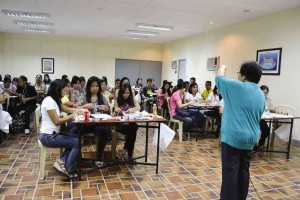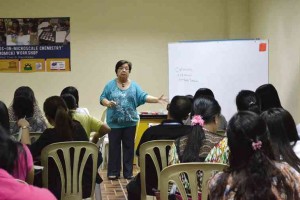Teaching science out of the box

SALUMBIDES lectures on “Homomich” and demonstrates how to use the contents of the Laboratory in A Box (LAB).
The room echoes with “oohs” and “aahs” as the balik (returning) scientist unravels “highfalutin” concepts through simple experiments using materials from a portable plastic box.
Like zealous students in a classroom, sometimes talking in chorus, the public school teachers start sharing their observations and theories as to why drops of water form a spherical shape on a 25-centavo coin during one experiment. They conclude that it must result from molecular attraction and surface tension.
Each time Department of Science and Technology (DOST) balik scientist awardee Cora Salumbides recounts her former students’ observations whenever they would do experiments, the teachers cannot help but smile and laugh. Some can already picture the excitement on their own students’ faces when they finally introduce the same experiments in their classrooms.
With matching hand gestures and facial expression, Analee Malazzab of Manila High School predicts the students’ response will be “Yes! Aha! iBilib” (a combination of the titles of local science television shows). “The students will definitely enjoy this kind of activity. Sabik sila (They are eager),” says the third-year chemistry teacher.
Salumbides, a Science education consultant at Jefferson Union High School in San Francisco, California, says: “More learning occurs when students enjoy what they are doing.”
Article continues after this advertisementInstead of bombarding students with complex terms like “surface tension,” why not make them discover the concepts by allowing them to experience, she asks the participants at the “Laboratory in A Box: Hands-on Minds-on Microscale Chemistry (Homomich)” workshop at the Philippine Science Centrum (PSC) in Marikina City.
Article continues after this advertisementLearning is fun
Homomich is a student-centered teaching method that combines fun and learning, says the professor, who is simply Ms S to her students.
What makes the approach more convenient for chemistry teachers in public schools is the time-saving, money-saving box called Laboratory in A Box (LAB).
Inside the box are packets of chemicals and improvised mini versions of various apparatus. They include 50 pipettes, 25 acetate films, 25 plastic cups, 30 straws, an improvised graduated cylinder, cookie for electrolysis of water and household chemicals, like salt, baking soda, baking powder and starch.
Using the LAB, teachers can come up with 17 experiments that will unleash the students’ creativity and help them go beyond memorizing terms to fill in the blanks on a test paper, Salumbides says. “That is when learning occurs.”
The box offers a substitute to expensive chemicals, breakable test tubes, beakers and other laboratory equipment. It is handy and ideal, especially in the Philippines, where, as Salumbides points out, saving is not just an option but a must.
Teachers agree that “scarcity of materials” is a major problem at public schools.
Marilou Amoyen, a third-year chemistry teacher at Gregorio Perfecto High School (GPHS) in Manila, says students are “willing” to learn but lack of resources hinders them from conducting experiments.
Christina Meneses, also a GPHS teacher, says she uses her own money sometimes to buy chemicals for laboratory activities.
Meneses, who has been teaching science for 21 years, adds that students love doing experiments.
“Pa-experience” is one of the students’ favorite expressions, the teachers say in a group interview. The children often race to volunteer in class experiments.
Experiments excite
Amoyen says students get excited when they observe chemical reactions but what they really want is to hold the instruments and do the experiments.
With the LAB and the teacher’s manual, Amoyen and Meneses hope they can give their students the learning experience they deserve.
Joanne Sugala, who has been practicing microscale chemistry or the use of minute quantities of chemicals in her classes since 2010, notes students’ change in attitude toward learning and the improvements in their grades. They are also able to save money.
“We used to spend a lot on chemicals because the experiments in our workbooks required the use of more than
5 milliliters of a substance,” says Sugala, a third-year chemistry teacher at Highway Hills Integrated School in Mandaluyong City. “This method is more economical because it only requires drops.”
Since only small amounts of chemicals are needed, every student in class is able to do the experiments, she adds, unlike in traditional laboratory settings, where only one or two are able to try.
Students become more attentive and participative when there is a class activity, she says.
Salumbides, who taught chemistry and physics for 30 years in California, believes LAB is the answer to making “science more exciting.”
She is pushing for microscale chemistry to be part of the curriculum and has already talked to some government officials. So far, however, nothing has been done.
So, in the meantime, with the help of the DOST and PSC, the US resident comes to the Philippines once or twice a year to conduct Homomich workshops because “this is what we need.”
The retired professor started introducing the teaching method to science teachers in the country in 2009, with the help of PSC.
This year’s workshop is sponsored by the United Nations Educational, Scientific and Cultural Organization.
The 50 teachers who are here for the one-day training have been chosen by the Department of Education from different public high schools in Metro Manila.
PSC’s programs and communications head Luis Lesigues says they have conducted 50 workshops and trained around 1,600 teachers from different parts of the country since 2009.
E-mail the author at [email protected].
